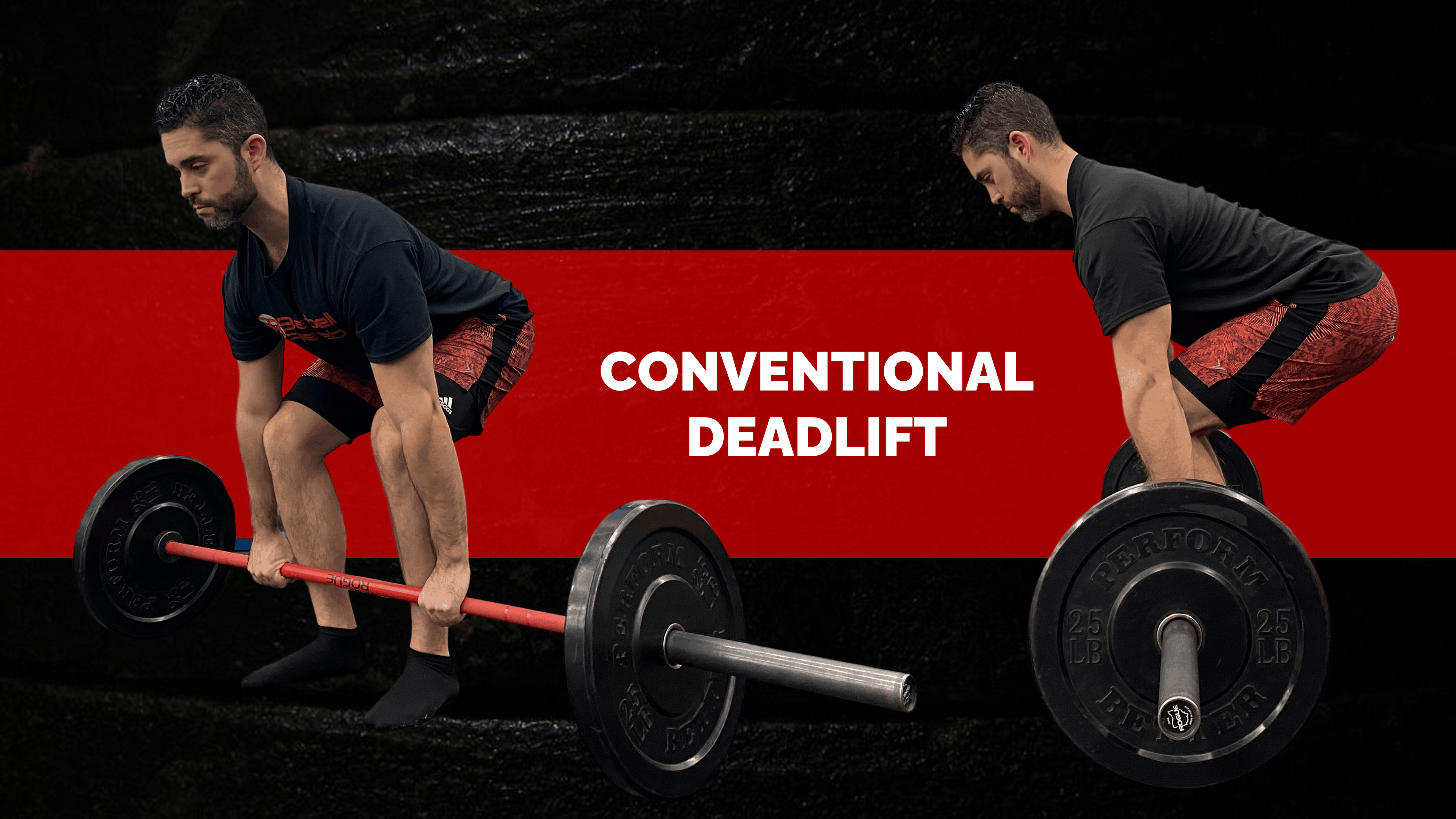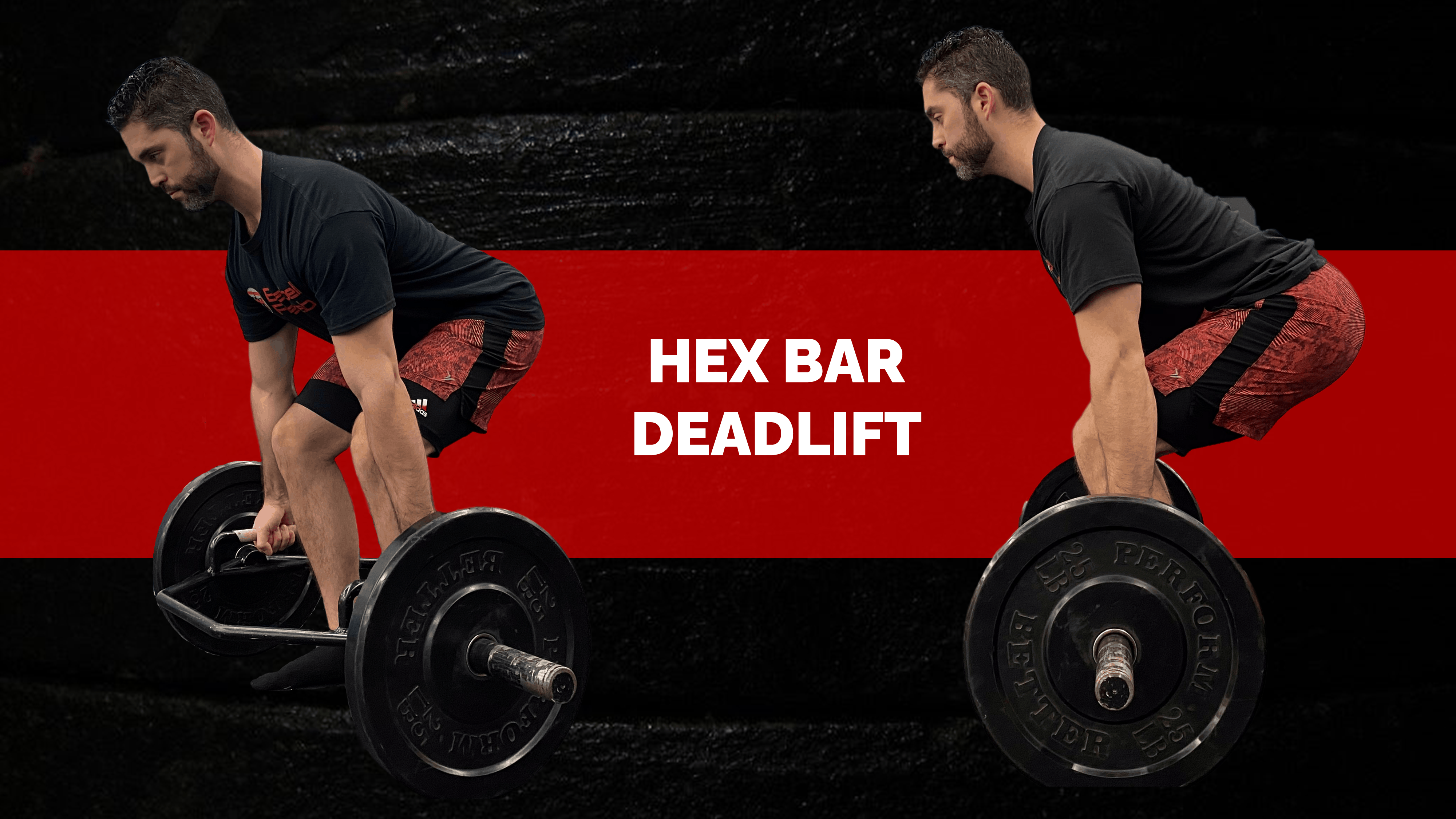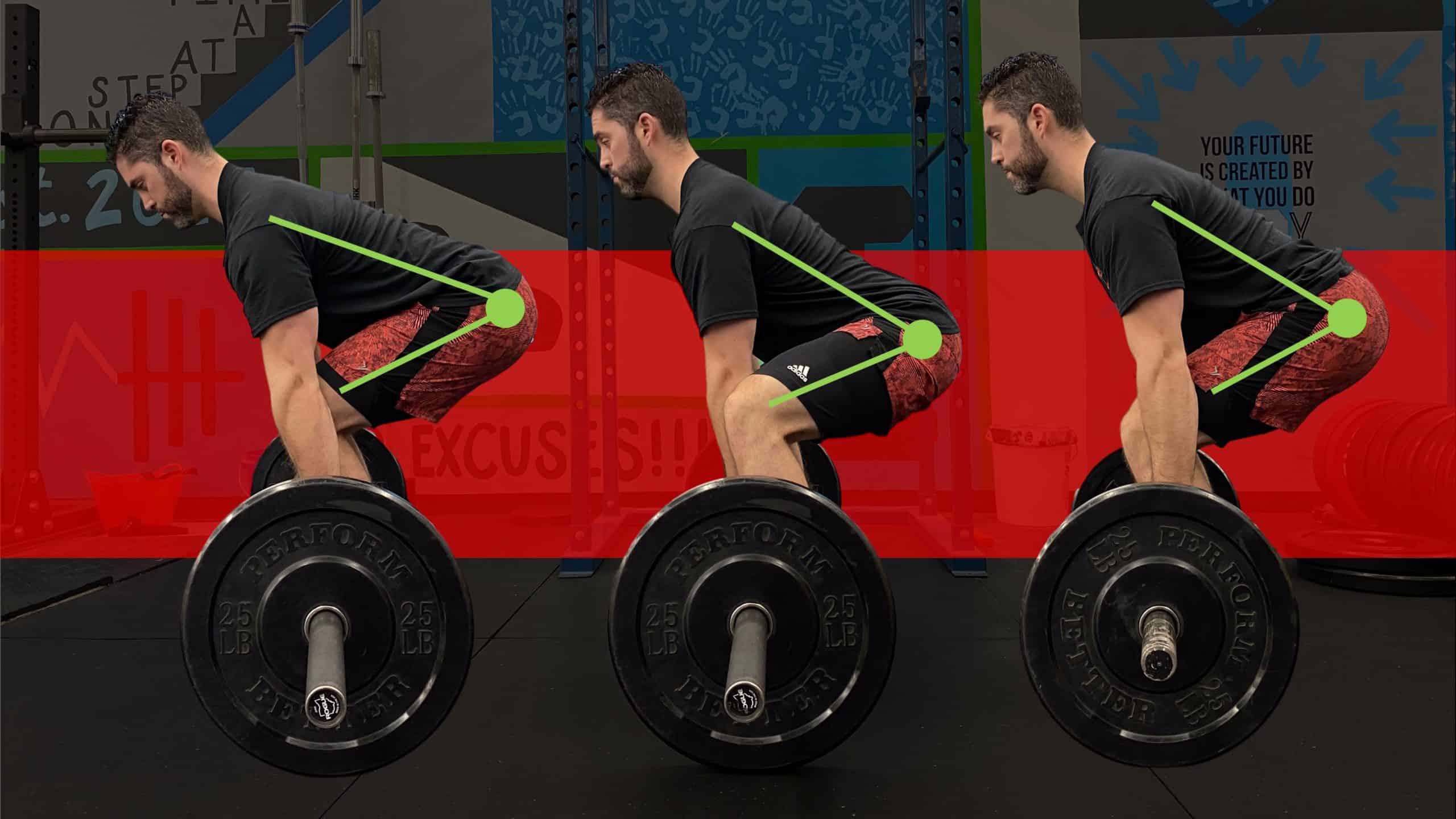Whether you’re a field-sport athlete or barbell athlete looking to improve your health/wellness, there are two key lower body movement patterns that you should be using to build endurance, strength, power, and full-body capacity. These patterns, plus their many variants, are the squat and the deadlift.
Today, we’ll talk about the deadlift. Specifically, we’ll talk about three different variants of the deadlift: conventional, sumo, and hexagonal-bar (hex/trap-bar). Other variants include the stiff-leg, Romanian, single-leg, and kick-stand deadlifts.
What is a Deadlift?
So… what is it that ties all of these lifts together under the name ‘deadlift’? Generally speaking, the common factor between all of these lifts is the ‘hip-hinge’ movement pattern.

A hip-hinge movement pattern can be defined as: ‘a lower body exercise with a bias toward hip extensor muscular dominance, over knee extensor muscular dominance.’ Said another way, the hip musculature will contribute more range of motion to the movement than the knee musculature will.
The deadlift is a full body exercise which should be included into your clients' programming, using the variant that best fits their goals, abilities, and preference.
The Deadlift: General Execution
Escamilla et al. say: “The starting position for the deadlift is with the lifter in a squat position, arms straight and pointing down, and an alternating hand grip used to hold a bar positioned in front of the lifter’s feet.
According to the American Drug Free Powerlifting Association (ADFPA) rules at the time of this study, the barbell is "lifted upward in a continuous motion until the lifter is standing erect with knees locked and the shoulders thrust back.”

In the set-up of the conventional deadlift, the lifter approaches the bar with their feet roughly hip width apart and hands grasping the bar outside of their knees. Feet are generally facing straight forward or slightly pointed away from each other (‘toed-out’). Either a double-overhand or alternating grip (one forearm pronated, the other supinated) can be used.

In the sumo deadlift, the lifter approaches the bar with their feet much wider than the conventional deadlift (2-3x wider), commonly toed-out. The lifter grasps the bar with their hands inside of their knees. A double-overhand or alternating grip can be used here as well.

With the hex-bar deadlift, a specialty barbell in the shape of a hexagon allows the lifter to stand inside of it. The lifter can then grasp either the ‘high-handles’ or ‘low-handles’ in a neutral forearm position on either side of their body.
Range of Motion Considerations for Different Deadlift Variations
With the conventional deadlift as a reference point, the vertical displacement of the bar from starting position to lift completion is 22% shorter in a high-handle hex-bar deadlift (1) and 20% shorter in a sumo deadlift (4). Therefore, a sumo or high-handle hex-bar deadlift will decrease the global range of motion requirements of the lift compared to the conventional deadlift.
In practice, this holds true in that the conventional deadlift typically feels more technically demanding to a novice lifter than the sumo or hex bar deadlift.
The Deadlift Starting Position: ROM Explained

Comparing the range of motion requirements at the starting position, or ‘lift-off’, both the sumo deadlift and hex bar deadlift will lead to a more upright torso compared to the conventional deadlift (3).
The hex bar deadlift starting position demonstrates increased knee flexion of ~6° compared to the starting position of the conventional deadlift, while the range of motion at the hip and ankle is similar between them (3).
The sumo deadlift has been shown to start with 10° decreased hip flexion and 4° decreased ankle dorsiflexion compared to the conventional deadlift, but similar knee flexion angles when a 3-D analysis is utilized (4).
All three variants demonstrate some difference in bar path between starting position to lift completion, but generally are executed with the goal of a vertical bar path (2). At lift completion, the hip, knee, and trunk should be erect, with shoulders in resting anatomical position.
Muscular Considerations between Deadlift Variations
The hex bar deadlift demonstrated significantly greater normalized EMG values for the vastus lateralis (quadriceps) during both the eccentric (down-phase) and concentric (up-phase) phases, compared to the conventional deadlift.
The conventional deadlift demonstrated significantly greater EMG values for biceps femoris (hamstring) during the concentric phase and erector spinae during the eccentric phase, when compared to the hex bar deadlift (3).
As such, you can make the argument that the conventional deadlift is more posterior-chain dominant than the hex bar deadlift. The hex bar deadlift can be considered a more ‘quad dominant’ deadlift variant, although remaining an excellent posterior-chain lift.
The sumo deadlift demonstrated significantly greater EMG values for both the vastus lateralis and vastus medialis (quadriceps) compared to the conventional deadlift. Additionally, the sumo deadlift demonstrated significantly increased tibialis anterior excitation compared to the conventional, likely due to maintenance of balance due to the aforementioned decreased dorsiflexion at the ankle. Conversely the medial gastrocnemius demonstrated significantly increased excitation in the conventional.

Escamilla et al. found that EMG activity at T12 and L3 (paraspinal muscles) demonstrated no significant difference between sumo and conventional deadlifts. Surprisingly, no significant differences were found in hip adductor EMG between the two variants, despite the much wider stance found in the sumo deadlift.
Globally, it was demonstrated that both the conventional and sumo deadlift had higher excitation of quadriceps, tibialis anterior, hip adductor, gluteus maximus, L3 and T12 paraspinal, and middle trapezius during the portion of lift closer to the floor; and greater excitation of hamstrings, gastrocnemius, and upper trapezius activity during the portion of the lift closer to ‘lock-out.’ (5)
Wrapping Up the Differences: What Does it All Mean?
The results of these papers, overall, indicate that all three styles of deadlift are excellent for recruitment of posterior chain musculature, but provide some distinct differences.
The biggest difference between the lifts is increased quadriceps excitation during both the sumo deadlift and hex bar deadlift, compared to the conventional deadlift.
The conventional deadlift, on the other hand, demonstrates more overall hamstring (concentric) and erector spinae (eccentric) excitation, than the hex bar deadlift.
Conventional and sumo deadlift paraspinal (including erector spinae) and hip adductor excitation were similar.
Other Considerations: Power, Force, and Velocity
When it comes to measures of power, force, and velocity, we also see some distinct differences between deadlift variations. For instance, the conventional deadlift demonstrated significantly more mechanical work than both the sumo and hex bar deadlift, due to the increased linear displacement from starting position to lift completion.
The conventional deadlift also demonstrated a higher average concentric velocity (ACV) than the sumo deadlift. The authors state that this is likely due to increased linear displacement of the conventional deadlift allowing for a higher velocity from the sticking point of the lift (roughly at the knees) until the lift’s completion.
Peak concentric velocity was similar between the conventional and sumo deadlift (6). Peak moment at the hip was similar between variants but peak moment at the knee was greater in the sumo deadlift. Cholewicki et al. demonstrated an increased L4/5 back extensor moment in the conventional compared to the sumo deadlift.
The hex bar deadlift demonstrated increased peak power, peak velocity, peak force, and mean force compared to the conventional deadlift. Mean velocity and mean power were similar between lifts. These results held across both 1RM and submaximal loads.
With a high-handled hex bar deadlift, peak power was achieved with 40% 1RM, while 30% 1RM achieved peak power with the conventional (1, 2). The hex bar deadlift significantly increased the peak moment at the knee and decreased the peak moment at the low back and hip compared to the conventional deadlift.
Final Thoughts and Recommendations
The conventional, sumo, and hexagonal bar deadlift are excellent options to incorporate within the program of both your performance and rehabilitation clients.
All three will load the entire body with an emphasis on posterior chain musculature, including the glutes, hamstrings, and paraspinals. The best option for your client is the variation that fits their goals, current abilities/tolerance, and preference.
Indications for the Conventional Deadlift:
- Maximize hamstring and paraspinal workload
- Increase total mechanical work
- Build capacity and confidence in client’s ability tolerate stress in their low back and hip
Indications for the Sumo Deadlift:
- Increase quadriceps workload
- Strengthen hip adductor musculature in a wide stance
- Decrease low back stress during early-phase low back rehabilitation (if needed)
- Decreased overall range of motion requirements compared to conventional deadlift
Indications for the Hex Bar Deadlift:
- Increase quadriceps workload
- Maximize force, velocity, and power production
- Decrease low back stress during early-phase low back rehabilitation (if needed)
- Decreased overall range of motion requirements compared to conventional and sumo deadlifts
References:
- Lockie, Robert G, et al. “The 1 Repetition Maximum Mechanics of a High-Handle Hexagonal Bar Deadlift Compared With a Conventional Deadlift as Measured by a Linear Position Transducer.” Journal of Strength and Conditioning Research, vol. 32, no. 1, 2018, pp. 150–161.
- Swinton, Paul A, et al. “A Biomechanical Analysis of Straight and Hexagonal Barbell Deadlifts Using Submaximal Loads.” Journal of Strength and Conditioning Research, vol. 25, no. 7, 2011, pp. 2000–2009.
- Camara, Kevin. “An Examination of Muscle Activation and Power Characteristics While Performing the Deadlift Exercise with Straight and Hexagonal Barbells.” 2015.
- Escamilla, R F, et al. “A Three-Dimensional Biomechanical Analysis of Sumo and Conventional Style Deadlifts.” Medicine and Science in Sports and Exercise, vol. 32, no. 7, 2000, pp. 1265–1275.
- Escamilla, Rafael F, et al. “An Electromyographic Analysis of Sumo and
- Conventional Style Deadlifts.” Medicine and Science in Sports and Exercise, vol. 34, no. 4, 2002, pp. 682–688.
- Kasovic, Jovana, et al. “Kinematic Differences Between the Front and Back Squat and Conventional and Sumo Deadlift.” Journal of Strength and Conditioning Research, vol. 33, no. 12, 2019, pp. 3213–3219.

